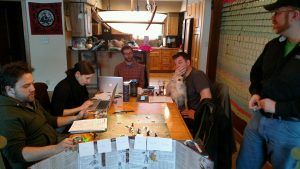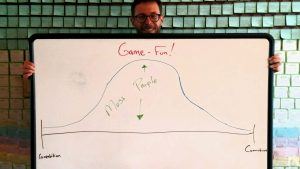by Max Sirak

For the better part of a year I’ve been working with a behavioral and family play therapist.
No. Not like that.
I’ve been helping her write her book. Because, it turns out, for writers undaunted by long term projects, ghostwriting is a fairly lucrative freelance option. At least, as far as keeping food on a table and a roof overhead go.
My favorite part of ghostwriting is the learning. It’s my job to absorb my client’s wisdom, gained from their years of experience, distill it, and use my words to make it fit for general consumption. The process itself all but guarantees I’ll encounter new ideas to sip, swill, and savor.
Having just finished ghostwriting a chapter on the therapeutic power of board games and averaging at least one game night a week with my friends, I’ve had games on the brain lately. And, because of it, I’ve stumbled upon some interesting connections I’d like to share. To explore them, we’ll answer three questions: Why do people play games? How does a person’s reason for playing affect the way they view other players? And finally, what traits and behaviors are being nurtured by the way a person plays?
Why Do People Play Games?
Actually, the answer to this question is pretty simple. People play to have fun. Where things begin to get interesting is in the way people go about finding their in-game fun.
Zooming way out, there are two basic and opposite places to find fun in games. Competition and connection are the black and white poles anchoring the gray spectrum of where game-fun is found. That is to say, most people’s enjoyment of games lies in the murky middle, somewhere between connecting and competing.
This makes a bell curve a handy visualization tool. Most people fall under the bulge. Some sprawl to the sides.
Even though the messy middle is where most of us operate in real life, it’s not the best place to stand for analysis and abstraction. It’s far easier to see connections and links between concepts when closer to the poles. So, from here on out, let’s accept most people are gray, but it’s more useful for us, here and now, to be black and white in order to learn.
Effects of Where Fun Is Found
Competitors and connectors treat the people they play with differently. Both groups need other players, but diverge as to why. The former derive their value from others. The latter with others.
This distinction revolves around victory.
Winning and losing are inherently linked. Defining one creates the other. Winners are non-losers and losers are non-winners. This makes winning/losing a duality, just like darkness and light. (Light is non-darkness. Darkness is non-light. Both are defined in terms of the other.) Make sense?
However, it’s the subjective felt experience accompanying winning and losing that causes the from/with divide. See, winning feels good and losing doesn’t. When someone feels good it’s much easier for them to feel good about their general value and worth. Likewise, when someone feels bad, it’s much easier for them to diminish their own value and worth.
And, the dualistic nature, along with the felt sense of winning and losing, means all good feelings of victory necessarily come with all the bad feelings of defeat. This creates an almost vampiric, bullying relationship between competitors and their fellow gamers. The joy they find in playing games (winning) carries alongside it a misery to those they play with (losing). This is why I say competitors derive their value from others.
Connectors don’t. They play games for the social aspect. It’s the sharing of time and space with others that matter to connectors, not winning. And, since they aren’t seeking the benefit of good feelings that winning brings, they aren’t forcing those they play with to pay its cost. So, connectors find their enjoyment with others.
Traits and Behaviors
Now that we’ve outlined the two major fun-sources/poles of the spectrum and the effect they have on the other people playing, it’s time to take a look at the traits and behaviors associated with each. Competing means focusing inward. Connecting means turning outward.
Those who compete are most concerned with their own well-being. The fun they find in playing games with others lies in besting them. This produces the good feelings of winning which in turn generates the boost to self-esteem. And, again, it’s a boost that exacts an emotional toll from others.
Because of the parasitic relationship competitors have with to those they play with, keeping their focus locked onto themselves is advantageous. The more tunnel vision a competitor can have on their own experience, the less they notice other players’ experiences. This is good. It prevents competitors from being affected by the negative impact their actions and choices have on those around them.
There’s a term in psychology for people who are either unaware, or unmoved, by the way their actions affect others – sociopaths.
Connectors are more concerned with others. These players find their fun in the opportunity games provide to be social. Coming into contact with others and creating shared experiences is why connectors play in the first place. This focus on sharing lends itself to caring about the other gamers.
Before going further, I need to point out a simple truth: It’s more fun to spend time with other people who are having fun. It just is. And, because spending time with others is the true goal of connectors, and it’s more fun to spend time with people who are enjoying themselves, connectors work to raise the tide of the entire joy-pond, not merely their own well of being.
But in order to do this, connectors have to pay attention to the people they are playing with. By tuning into others, they’re able to become aware of how they’re feeling. Psychologists happen to have a term for this sort of behavior too – empathy.
Some Things To Chew On…
Did I just say all winners are sociopaths? No.
Did I just say empathy is for losers? No.
What I did say, at the beginning, is competition and connection serve as the two anchors between which the gray tapestry of game-fun flies. And, depending whereupon that tapestry you happen to fall, points to some general tendencies. I just thought you might like to know.
Now – go trounce your seven-year old niece and savor her sorrow – you vampire, you.
Or – throw the game and let her win.
I guess it all depends on where you find your fun.
